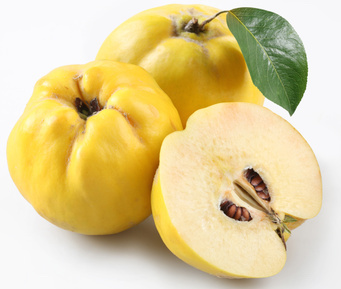
Health Benefits:
Anti fungal
Anti inflammatory
Anti viral qualities
Detoxifying effects
Fights migraines
Helps control LDL cholesterol levels
Improves hair skin and nails
Lowers blood pressure
Prevents sinusitis
Reduces risk of bladder cancer
Reduces risk of cervical cancer
Nutrition:
Serving size: 1 fruit; Calories: 52; Fat: .1g; Cholesterol: 0mg; Sodium: 4mg; Carbs: 14g; Fiber 1.7g; Sugars: g; Protein: .4g; Potassium: 5%DV; Vitamin A: 0%DV; Vitamin C: 23%DV; Calcium: 1%DV; Iron: 3%DV
Did You Know?
- The quince is a relative of the pear and the apple.
- Wrap quinces in a plastic bag and refrigerate them for up to 2 months.
- Due to their high levels of tannins, in the raw form they tend to be acidic and not very tasty.
Ways to Eat:
- Poached
- Baked
- Jellies, Jams
- Puddings
- Different countries use in different ways
Farming Trivia:
- Native to the Caucasus and Iran, the quince was known as the ‘Pear of Cydonia’
- Today, the quince is also found in Latin America, the Middle East, and the United States
Note: Always consult a physician for any specific health questions and concerns. Some of this information may be subject to change should there be any new findings from Federal Health Administration (FHA), Food & Drug Administration (FDA), American Medical Association (AMA), American Cancer Society (ACS), and / or other leading food, nutrition and medical advisors.

